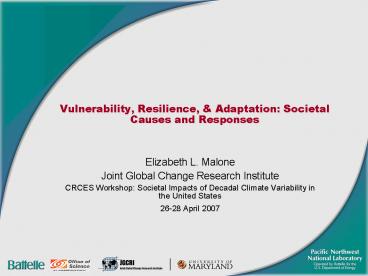Vulnerability, Resilience, PowerPoint PPT Presentation
1 / 13
Title: Vulnerability, Resilience,
1
Vulnerability, Resilience, Adaptation Societal
Causes and Responses
- Elizabeth L. Malone
- Joint Global Change Research Institute
- CRCES Workshop Societal Impacts of Decadal
Climate Variability in the United States - 26-28 April 2007
2
- Will better information
- i.e., predictions about climate variability and
change and their impacts - help societies build resilience and adaptive
capacity? - Answer Not necessarily, unless people see how
such information relates to their lives and their
future.
3
Rationale for studying vulnerability, resilience,
and adaptation
- These connect climate with societal issues, such
as development and well-being ? salience. - By assessing current vulnerability, resilience,
and adaptive capacity, we gain insight into
current dependence on climate and can extend that
insight to climate change. E.g., current lack of
adaptation to current climate may mean less
resilience/more vulnerability in the future. - Once the climate-society relationship begins to
be defined, information about future climate
becomes more important.
4
Why the Vulnerability-Resilience Indicators Model
(VRIM)?
- Changes the focus from physical impacts to
meaningful societal consequences - Brings together social, economic, and
environmental factors - Summarizes information via quantitative
indicators - Scenario-driven, i.e., allows different future
conditions to be explored - Allows comparisons (unlike most case studies)
while preserving transparency (in sources of the
scores).
5
Important Concepts
- Vulnerability capacity to be harmed composite
of sensitivity, adaptability, and exposure - Resilience the ability to cope with or recover
from exposure or shocks - Sensitivity the degree to which changes and/or
variability in climate lead to changes in system
attributes - Adaptation adjustments in anticipation of or in
response to climate change and/or variability - Adaptive capacity the ability to adjust to new
conditions - Exposure climate stimuli that affect a system or
region
6
Source Brenkert and Malone, 2005.
7
Sensitivity
- Ecosystem sensitivity
- Percent irrigated land
- Fertilizer use
- Water security
- Water availability (demand/ supply)
- Precipitation amount
- Human health
- Fertility rate
- Life expectancy
- Human settlement and infrastructure
- Population at flood risk from sea level rise
- Population without access to clean water and
sanitation - Food Security
- Cereals production/ crop land area
- Protein consumption/ per capita
8
Coping and adaptation capacity
- Economic capacity
- GDP per capita
- Equity index
- Human capital
- Dependency Ratio
- Literacy rate
- Environmental capacity
- Land use measure ( unmanaged land)
- SO2 emissions per unit area
- Population density
9
Example Mexico rankedamong countries second
quartile
63rd of 160 countries
10
(No Transcript)
11
The states with the highest and lowest resilience
are similar in ecosystem resilience and close in
environmental capacity, but differ greatly in
settlement security, food security, human health,
human resources and economic capacity
12
Comparison of projected resilience of two Mexican
states
13
Assessing resilience and adaptive capacity
reveals policy spaces for building both
- Although geographic and climatic conditions are
important, even more important are the
social-ecological systems in a region. - Results lead to the next set of questions about
policy priorities in an area but clearly
different places have different policy needs. - The VRIM country-level adaptive capacity results
have been combined with projected climate change
from the COSMIC model to show that impacts may
well outrun adaptive capacity in most places
during this century (Yohe et al. 2006).

